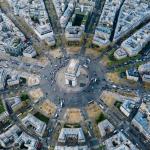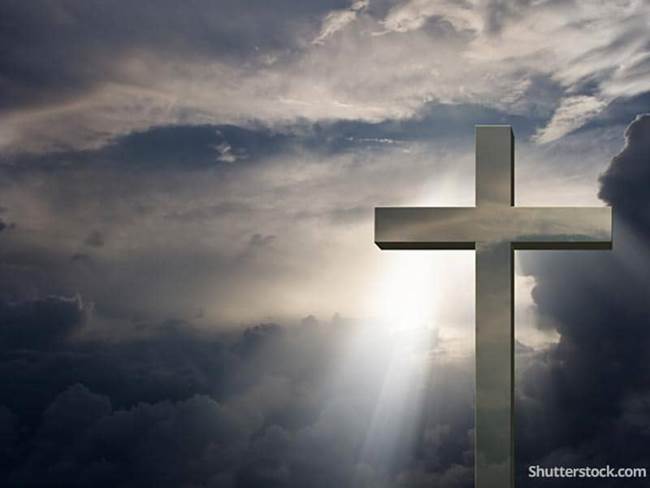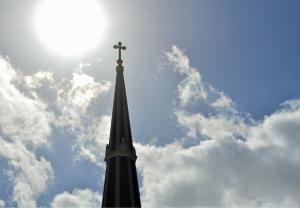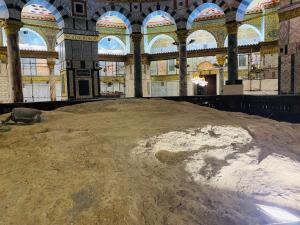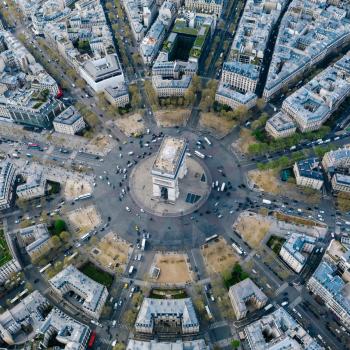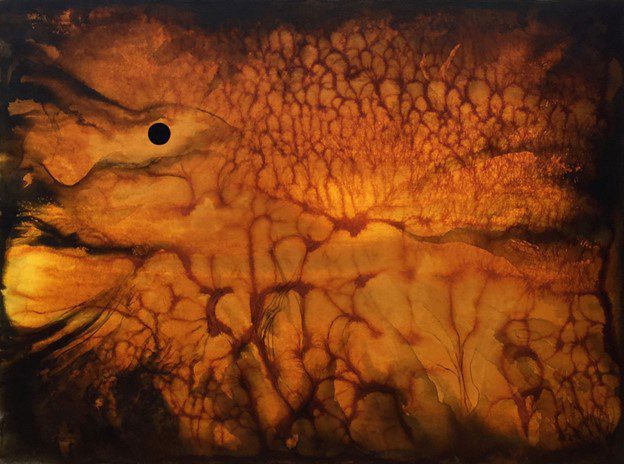
Acrylic on canvas
36″ x 48″
2021
“I fit into the under-recognized older women artists category. My work is particularly difficult because you cannot put it in a box and say, ‘Okay, she was a feminist. Okay, she was an environmentalist. Okay, she was a humanist. Okay, she was an intellectual. Okay, she was an incorrigible ecumenical spiritual seeker.’ It’s all of the above!”– Beth Ames Swartz.
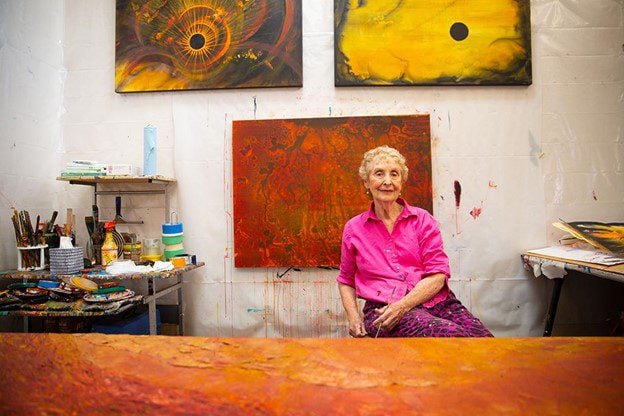
Beth Ames Swartz in studio with three 36″x48″ paintings behind her from the Broken World series
As a Muslim creative girl growing up in the United States, my parents instilled in me the idea that my upbringing would prevent me from ever being accepted in American society, because I would not have shared the same spiritual background experienced by most of the country. Their comments sparked a flame in me to challenge this frightening thought and prove it wrong. Was it true that I would always remain an outsider to my neighbors? I wasn’t someone to hate, or fear, and I wasn’t unapproachable. I was, I believed, like any other girl. I wanted to be happy and live a normal life, because really, how different could I be from them? My parents’ fears on my behalf were how they showed love, but I wanted to find the core of shared values of what makes us human.
My mission has been to find the connections between my life and beliefs and those of my neighbors, without needing to distance from my faith. I learned of the artist, Beth Ames Swartz after a curator recognized my passion in philosophizing on the core of what makes us human. Like me, she is a creative woman who emerged from a spiritual practice outside American demographics (Judaism for her and Islam for me), and we both see every religious ideology as a continuum of humanity and human interpretation of how we can carry inner peace from this earthly life to the life hereafter. Since the 70’s, Beth Ames Swartz has studied spiritual systems and found artistic methods to visually interpret the synchronicity between faith and art. Swartz goes on journeys to understand how her femininity, the physical earth, healing, and spirituality synchronize together to create an experience in visualizing healing in art. Typically, she spends several years on each series to fully encapsulate a religious or philosophical wisdom system from Buddhism, Chinese medicine, Native American spiritual practices, Christianity, Judaism, and Islam. Swartz fearlessly innovates her artistic methods of shaping planes, layering paper and paint, and looking to natural stones such as mica, quartz, amethyst, and chrysocolla as media. Establishing connections with The Ojai Foundation, making pilgrimage to nature sites across Arizona, New Mexico and international sites, and meeting with a Hopi medicine man, shaman, and Rabbis have been crucial experiences influencing the evolution of Swartz’s art. Throughout her career these experiences and profound studies of esoteric wisdom systems have resulted in abstract, electric color fields of landscapes, human figures, animals, and spiritual symbols.
I appreciate how Swartz – in her abstractly empowering feminine manner – honors the differences of spiritual systems in her art seeking our common quest for love, wisdom, and enlightenment. Simultaneously, she establishes the importance of the feminine voice in abstract art, where feminism and divinity are often left out of the discussion, and women artists are underrepresented among the field’s spiritual and creative innovators. As a woman, having purpose in my life inspires me to live a life of agency in my role as a creative; where I can live my life in totality in relation to what I create and humanity as a greater whole.
Beth Ames Swartz was born in New York in 1936 to an intellectual Jewish family. She attended Cornell for her Bachelor of Science degree and later attended New York University for her Master of Arts degree before working in arts education as a teacher. At 23, she married her first husband, lawyer Melvin Jay Swartz, and moved to Phoenix, Arizona. Soon after in the early 70’s, she took two life-changing rafting trips down the Colorado river into the Grand Canyon. Taking her sketchbooks on the expeditions, she absorbed the colors in the canyon and her palette expanded as well as her connection to the earth; literally bonding to the earth as feminine shapes emerged in her drawings and paintings. This inspired her to make constructive changes through meditation, pouring watercolor and acrylic paint and exploring how to replicate earth’s elements. These trips changed her art as she embarked on several series on the elements that sustain life; air, water, prana (spiritual energy), and earthflow. However, when Swartz came to the element of fire, she knew she had to work with fire as an artform. On her rafting trips, she had felt the embrace of Mother Earth and a calling to express her spirit. Drawn to the earth, Swartz bonded to it more than she had to her family.
In the mid-70’s, Swartz expanded from the flow of water and color on paper to the flow of smoke imagery on paper, eventually developing a process/ritual that replicated the life/death cycle but adding rebirth, or what she called “reordering”. Going to sites around Arizona, Swartz did her ritual in the landscape and after several series such as “Sedona” and “Monument Valley”, she decided she wanted to go back to Israel and honor women in Jewish history by taking a pilgrimage to reconnect with her spiritual roots. Swartz’s emotional connection to the ancient rocks and dramatic landscape during her raft trips allowed her to recognize her relationship to the earth and inspired her to pursue it further in Israel.
Swartz recognizes our cultural myth around Mother Earth and sees how the landscape of the canyon, river, and mountains is the powerful metaphor of how earth is woman and represents what it means to be a powerful woman in the world. Simultaneously, she recognizes the importance of the dualities of life: male and female, East and West, and human and earth. I felt a part of the conversation in her world because the masculine presence of God takes dominance in all religious denominations. She honors female divinity while voicing the integrity in the balance of the universe in the system we call life.
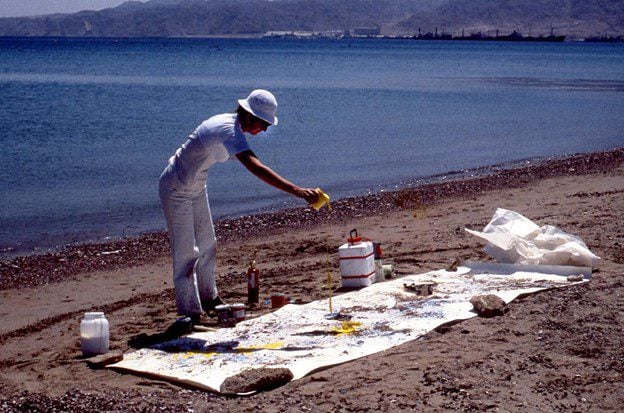
On site creation of Israel Revisited: The Red Sea #1 (IRTS #030) using fire work process-ritual.
1980
Her notable innovative art series, Israel Revisited (1980-1983), opened at the Jewish Museum in New York City and toured to the University of California at Irvine, the Hebrew Union College Skirball Museum, the University of Arizona Museum of Art, the Judah Magnes Museum, the Beaumont Art Museum, the Albuquerque Museum of Art. In Israel Revisited, Swartz looks upon the strength of women from the old testament who sought to find their purpose in life through their consciousness in seeking a connection with the divine. They are all manifestations of the feminine aspect of G-d in Judaism known as the Shekhinah. Kabbalists identify her as an aspect of each human that was separated and reunited with G-d and it is believed that the women in the Old Testament were aspects of the Shekhinah that were brought down on earth to teach lessons of divinity with as much reverence as prophets. As one of the first female rabbis Lynn Gottlieb testifies:
“Among many peoples there is a voice which echoes through darkness and brings in truth. Among Yehudim/Jews the voice is called by the name Shekhinah. Shekhinah calls out from the stone fragments of the western wall in the city of peace. She calls out in clear vision from the most ancient memory of cycle and patterns of change. She is the inner journey, the source of being, the first light of creation. Shekhinah appears and reappears in the traditions of story, prayer, ritual, poem and mitzvah of Yehudim. Shekhinah, God’s female presence, is called by many names: she is weeping woman, widow woman, woman at the wall … she is princess, queen, prophet, warrior, midwife … she is the bringing together of nations, the coming home of exiles. Among the writings of men, Shekhinah is experienced as being in exile. She becomes the unredeemed aspect of self. So they long for her, search for her, try to redeem her out of exile. But men have not looked to women’s spiritual insight as a way of bringing her home. For women’s lives, journeys, struggles, joys are Shekhinah’s unfolding. Women are rediscovering Her Presence inside their own voices . . . We are refinding the spiritual presence inside ourselves. We have not spoken our stories to each other in many generations. We are listening and speaking, remembering and restoring, creating and rejoicing through a new found wisdom. Returning to the earth is a deep part of woman’s spirit journey. Soil, trees, plants, sky, mud, stone are all ritual vessels, are all occasions for the deep listening we need to do in order to bring Shekhinah home. We are retelling the stories of our ancestors through our own voices. We are restoring the ability to name what we see.”
Gottlieb’s philosophy around the Shekhinah impacted Swartz to make it part of her daily spiritual practice to pray to Shekhinah through her art practice. Swartz embodies the role as a spiritual leader through her own reawakening in her role as an artist, seeking connection with the earth and her inner self. In this case, she reflects her love of Shekhinah in paying homage to women spiritual leaders such as Queen of Sheba, Rebekah, Rachel, Deborah, Dona Gracia, Miriam, and the Unknown Women respectively at their ten sacred sites. The process in creating these works entailed using the disruptive forces in nature to create spiritual art. At every sacred site, Swartz performed her process/ritual by using heavy rolls of watercolor rag paper and layering them with rice paper – burning areas with a blowtorch that were not wet then mutilating and burning the scrolls with various repetitions then finally covered the paper with soil from the sacred site and buried it for one lunar month. The papers were layered and painted with various methods until their elaborate final appearance was embraced by Swartz. The rhythm of repeating a technique over and over is like a prayer around an artistic practice and how the divine has tested humanity with finding balance in chaos with the end result of creating entirely new shapes for new connections to be found in the pigment.
Fire helps the land and animals who inhabit it, fire is a creative gift of the universe. Fire paints the universe, the willows, and trees; it is the root of the beginning of life. When Swartz paints and creates with fire, she is honoring the spirit of fire as a symbol of life and spirit. The active spirit of fire has its association with masculinity and the calm spirit of water is associated with femininity. Swartz balances the active power of fire and passiveness of her acrylic painted soil on canvas to create a harmony of creation where both sides are respected.
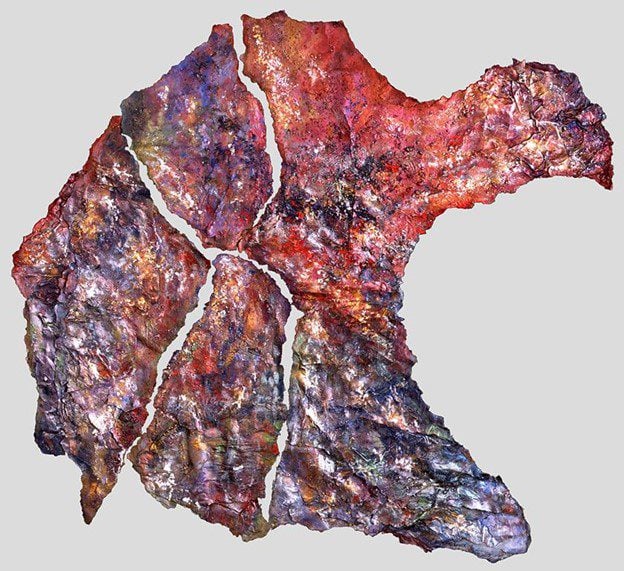
Artist: Beth Ames Swartz
Series: Israel Revisited, Ten Sites
Title: Safed #1
ID #: 001
Medium: fire, earth, acrylic, variegated gold leaf and mixed media on layered paper
Size: 47″ x 62″ (1.19m x 1.57m)
Date: 1980
In the first work of the series, Safed, No.1 includes the letter ALEPH, the first aspect of the Shekhinah which utilizes negative space mélange in the soil in the shape of an abstract human heart, honoring the source of light or Shekinah. It’s materiality of fire, earth, sunlight, and mixed media honors the ancient elements of fire, earth, air, and water. Aleph is the first letter in the Hebrew alphabet, it is soundlessly silent and the opening of the rest of the alphabet in the semitic language and it became the symbol for the number one (1) for the Greeks. Shekhinah is symbolized through the vocalization of breath where she is silently present in humanity but keeps humanity going, much like how women are vital to the world through making silent impacts in their roles as mothers, teachers, caretakers, and designers. In the work, Shekinah is as infinitely present in all of time as humanity is humbled to sustaining life in every breath in this crescendo of crimson red to patches of blue-green, and we see her as this flame, as the luminosity, light, and radiance.
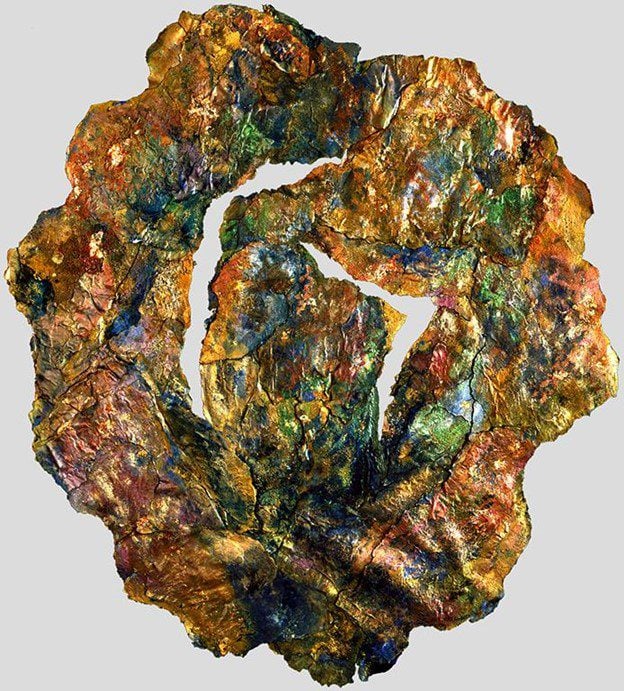
Artist: Beth Ames Swartz
Series: Israel Revisited, Ten Sites
Title: Bethlehem #1
ID #: 014
Medium: fire, earth, acrylic, variegated gold leaf and mixed media on layered paper
Size: 49″ x 44″ (1.24m x 1.12m)
Date: 1980
The fourth work in the series, Bethlehem #1 is dedicated to the story of Rachel, the wife of Jacob and mother of Joseph and Benjamin, where during her journey to Bethel, she died of childbirth. She is associated with the Shekhinah as the suffering mother. The work resembles a flower petal ring of circles unifying heaven and earth in the circle of life through the imperfect circle of earthy yellow brown with royal blue drizzling the abstracted layers of paper, signaling the chastity, purity, and humility of the feminine divine. The elements of the earth of unifying female fertility and beauty as a symbol of the divine. Swartz layers the earth and color through a process she innovated of order, reordering representing life, death, and rebirth. Swartz’s practice is the feminine spiritual practice in principle where femininity is the process of birth, rebirth, and transformation where the masculine subsides only in the principle of being born because the masculine can only be born. The feminine is the rebirth, transformative practice, and the act of giving birth.
As women, we take on the many layered complexities of womanhood as daughters, friends, and professionals. However, being a creative woman adds a layer of complexity of dedicating life to living life with a bigger purpose of healing humanity through the journey of the heart as the artist. I can partake in the conversation around health, healing, and love as I am drenched in a color where I take on the mood of a color. I take on the feeling. I take on the spirit. As a woman, I take on empowerment. The abstract expressionist painter and art philosopher Wassily Kandinsky believed that artists were spiritual leaders; “Each one of them who can see beyond the limits of his segment is a prophet to those about him, and helps the advance of the obstinate whole”.
Swartz is revealing parts of herself as she pays homage to the female spiritual leaders in Abrahamic religion and the divine feminine as a whole. When I studied Arabic in university, part of the class exercise in classical Arabic was to listen and follow along to different passages of the Quran. There was a balance of gender where Allah shares the duality as Supreme (the masculine) and the Infinite (the feminine), as being referred to Huwa (He) and Hiya (She). Long after class was over, this knowledge stayed with me as I questioned the way the holy book is translated. Since English is not based on gender pronouns like Romance languages are, translators and theological scholars have chosen to refer to God as He, framing the general mindset of masculinity. I’ve questioned this translation choice as a reflection of sustaining values of male leadership in society and the success of social conditioning to refer to anyone with high power as male. Perhaps it may be a simple decision to worship the masculine qualities (strength and ruling) over the feminine ones (beauty and wisdom).
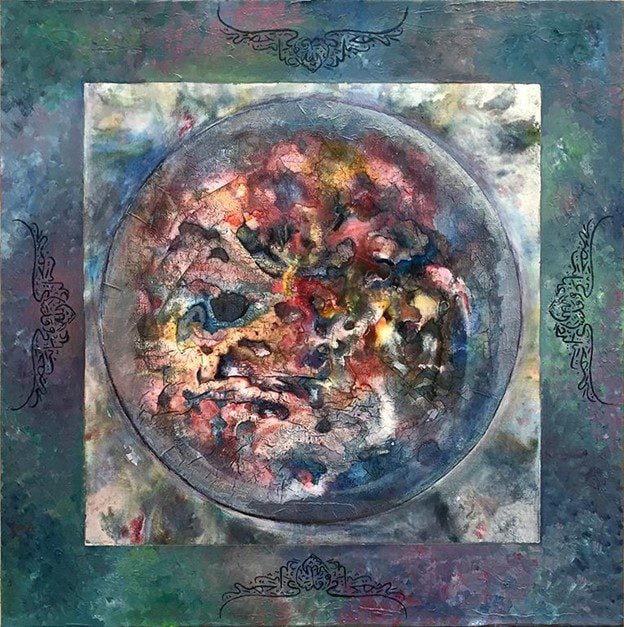
Artist: Beth Ames Swartz
Title: Tughra #5
ID#: 1046
Medium: acrylic, smoke and mixed media on canvas
Size: 30″ x 30″; 76cm x 76cm
Date: 2018
Swartz’s natural inclination of the search for the feminine divine continued in 2018, where when she spoke about her art at a Medical & Art Meeting in New Orleans and two Muslim physicians came up and asked her why she hadn’t tackled Islam in her work. This eye-opening question inspired her to start studying Sufism, the mythical aspect of Islam, and create her Tughra series (2020). Previously, she had not tackled this faith due to the system’s complex history. Tughra was exhibited briefly at The Shemer Art Center in 2020. In Sufism, Tughra, is known as a seal that linked correspondences between a sultan and the public through coins and official documents. This symbolic system inspired the leader of Sufism in America and Europe, Inayat Khan (1882-1927, India), where he chose tughra of a winged heart which translated from Arabic script to “May God’s message spread and purify your heart,” inspiring Swartz series of works.
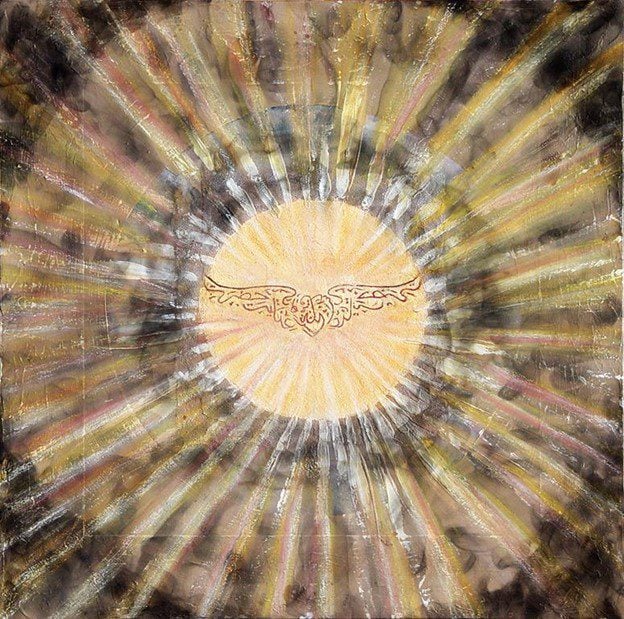
Artist: Beth Ames Swartz
Title: Tughra #4
ID#: 1046
Medium: acrylic, smoke and mixed media on canvas
Size: 30″ x 30″; 76cm x 76cm
Date: 2018
The circle of life is surrounded by four tughra seals implicating the miraculous messages of love God has sent down to people in the forms of family, charity, and nature. These seals are depicted in Tughra, No.5, where Swartz paints an abstracted bird’s eye view of colorful thick abstract brushstrokes contained within a perfect circle representing the supernatural energy that is blind to the human eye that makes the universe go round. It is the orb of perfected color from God in his creation of the universe. In Sufism, divine love is at the center of a lifelong journey to become the reflection of divine love. This is a symbolic act of attaining closeness to God on earth. Love is at the center of creation, as in God is the true creator of everything and everyone; God is love. We are passed down with love from the divine, the moment we are born with love from our mother’s womb. To achieve a point of balance in our souls it is to integrate the masculine and feminine aspects, as the famous Sufi poet Mevlana Jalaluddin Rumi (1207-1273) wrote, “Woman is the radiance of God; she is not your beloved. She is the Creator- you could say that she is not created.” To know the feminine self as in wisdom, is to know oneself, to know God.
In the Torah and the Quran, water is the life-giving force of creation, a source of power associated with the feminine. In Surah 109 in the Qu’ran, al-Kawthar, gives a revealing look into the Prophet’s [Muhammad (swh)] feminine soul. It was revealed because his enemies had been taunting him that he had no sons, only daughters, while they had been given sons to perpetuate their patriarchal ways. Allah revealed this message of consolation to the Prophet: “We have given thee al-Kawthar … surely the one who hates thee will be cut off (from progeny).” What is al-Kawthar? Al-Kawthar is a sacred pool of life-giving water in Paradise-a profoundly feminine symbol.” This concept is represented in Swartz’s work, Purification of the Heart #6, (2020) where God is depicted as the all-seeing, all-knowing eye in the center of the heart. God is genderless, in the shape of a heart and wings, where the white heart is greyed with dark shadows of human life and the movements that look like abstract faces above a background of blue standing for what manifests humanity, the ocean. It is a message of how the world is materialized beyond our eyes in human life as we are a part of a grander creation.
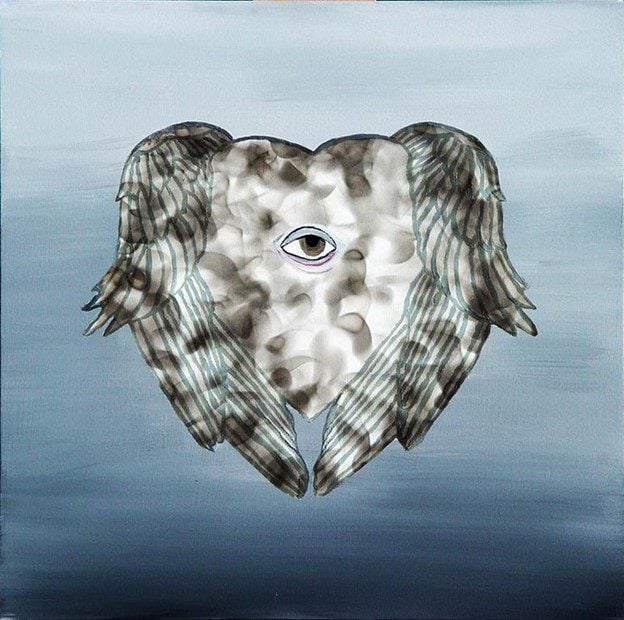
Artist: Beth Ames Swartz
Title: Purification of the Heart #6
ID#: 1053
Medium: acrylic and mixed media on canvas
Size: 24″ x 24″; 61cm x 61cm
Date: 2018
For the sake of ease in society, Swartz is labeled as a female artist, but to be an artist is to live beyond the words of having an art practice. Art is divine, art is an essence of healing that transcends the physical canvas. As Swartz says, “My parents were humanists and they were good deed doers, mitzvah doers and that it is our jobs as Jewish people in the healing of the world. That’s our job on the earth when we’re born, to be part of the healing of the world.” This concept of healing the world is known as Tikkun olam. Women care about humanity, because they birth it and the woman’s body becomes the source of nurture for the rest of their lives. By practicing the act of creating art without denying the pain, the traumas of the past heal, and using earthy elements on canvas with intent to spread the divine word, heals the earth and humanity. Oftentimes women feel the responsibility to share how their life’s ups and downs influences their craft, but Swartz is disarmingly direct regarding her life traumas and her healing journey through art. She frames it this way: she kept going with her practice because without it, she would have not survived. Every time she paints and studies a new spiritual philosophy, she makes a hero’s journey and takes us on the pathway with her. It’s in our hearts to be passionate in life, as for Swartz painting her connection to the divine in the heart shaped The Red Sea #1 from the Israel Revisited series where the deep reds evoke her connection to the Torah and her quest of her life to create art.
As I meditate on the shapes, layers, forms, and colors in Swartz’s work, she teaches me that it is a quality of strength to create fully from the heart. Where the emotions from inside my heart resonate with the hearts of others is where we all heal collectively. The role of the artist is to unify, not separate, in the act of creating, not destroying. Studying the layered coats of paint resembling the swirling western rocks I am reminded of my shared values to humanity. I don’t have to be afraid to go deeper into myself to find my traumas, study them and create art from them even if it takes many trials and errors in a fast-paced world focused on instant gratification. Every brushstroke is a word to a prayer made by the hand that runs quicker than the eye to fully visualize where the viewer is repeating after the preacher. The practice in doing as prayer is a continuation of the concept of Earthseed, Octavia Butler preaches in her novel, Parable of the Sower, “We are all Godseed, but no more or less so than any other aspect of the universe, Godseed is all there is- all that Changes,” where good actions with the intention of seeing humanity and the environment as living as a community implement positive change because enhancing the earth is prayer regardless of how you identify. Isn’t that the role of artists after all, to plant their spiritual seeds all over the world?
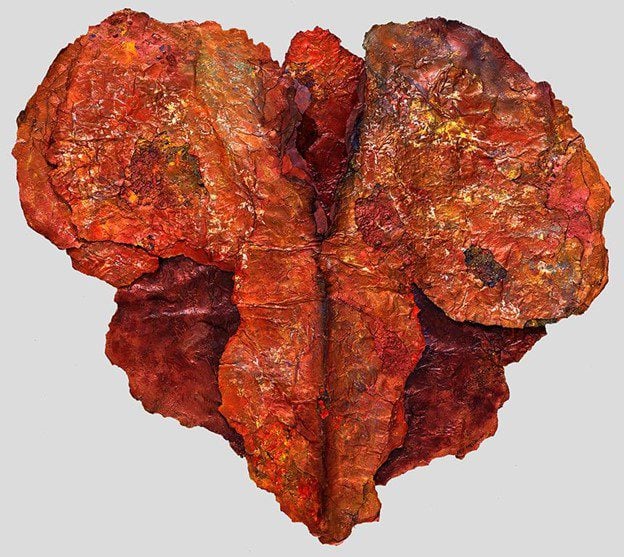
Beth Ames Swartz
On site creation of Israel Revisited: The Red Sea #1 (IRTS #030) using fire work process-ritual.
1980
For more information on Beth Ames Swartz, visit her website bethamesswartz.com and her Instagram @bethamesswartz
Sources:
Butler, Octavia E., et al. Parable of the Sower. Thornwillow Press, 2021.
Galian, Laurence. “2nd Annual Hawaii International Conference on Arts & Humanities.” The Centrality of the Divine Feminine in Sufism, 2003.
Kandinsky, Wassily, and Sadler M T H. Concerning the Spiritual in Art. Dover Publications, 1977.
Swartz, Beth Ames. Beth Ames Swartz. A Moving Point of Balance, Inc., 1988.
Swartz, Beth Ames. Inquiry into Fire. Scottsdale Center for the Arts, 1978.
Beth Ames Swartz: Israel Revisited. Jewish Museum, 1982.
Swartz, Beth Ames, et al. Reminders of Invisible Light: The Art of Beth Ames Swartz. Hudson Hills, 2002.
Eman Alami is a creative based in Los Angeles where she explores the intersection between creative writing, philosophy, and visual art. She is a graduate with a Bachelors of Art in Art History from the University of California Los Angeles and currently pursuing her Masters of Fine Arts at California College of the Arts.


